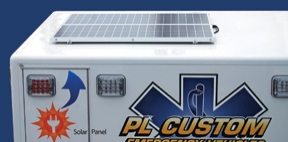 |
| Solar panels installed on San Rafael Fire Department’s E-52. |
 |
| An example of solar panels installed on a PL Custom ambulance. |
Some fire departments are using solar panels on their emergency vehicles to keep their batteries charged.
Harnessing the power of the sun is a relatively inexpensive way to save on maintenance and fuel costs, according to officials in two of those departments, and it benefits the environment. The more direct the sun, the better. But they said solar panels produce electricity even on a cloudy day, as well as in urban areas with tall buildings that can obscure the sun. The rate of charge is all that’s affected.
The San Rafael (Calif.) Fire Department and South Metro (Colo.) Fire Rescue Authority have each rolled out programs to outfit their fire apparatus and ambulances with solar panels. The purpose is to keep their 12-volt systems charged so they don’t need to remain at idle at an incident.
The San Rafael program in Marin County was put in place about five years ago and started off by outfitting a single engine with solar equipment. The program was so successful that the department outfitted all 22 pieces of its apparatus with solar panels.
Retired San Rafael firefighter Dave Holland, responsible for implementing the program, said he fields questions from all over the country from firefighters who want to know how the solar panels work and how to install them.
The program began after San Rafael officials started looking at ways to improve the performance of the electrical storage on their engines and ambulances. “We were able to drastically improve our in-house charging systems with modern day chargers,” Holland recalled. That improved the overall condition of the vehicle batteries, he said, and set the stage to find a way to maintain them once they left the station.
“Keeping all of our apparatus running when they were in the field was not very practical,” he said, “and it wasn’t in keeping with our evolving city-wide polices of reducing carbon footprints.”
Similar circumstances got South Metro Fire Rescue Authority officials thinking about solar panels. “The problem we were having was when [the medic units] were outside for four to six hours with no shoreline connected to them,” explained Fleet Services Bureau Chief Brian Brown. “So, we were trying to think of ways we could either turn things off or how we’d be able to charge things.”
The issue for both organizations was the number of items an ambulance or fire apparatus carries that drain the electrical system, even when a vehicle is shut down. When that happens, the batteries drop below a certain voltage, which drains the cold cranking amp (CCA) reserves on the batteries.
“The problem is that during the past few years, people have been adding more and more components that have a live drain on the system,” said Chad Newsome, national sales manager for PL Custom Emergency Vehicles in Manasquan, N.J. “Whether it’s computers for their dispatch or temperature-controlled cabinets, even when they shut the vehicle down, they are still drawing on the batteries.”
For those reasons, PL Custom began offering solar panels as an option on its ambulances.
An additional factor, Newsome said, is that many states now demand that operators shut the vehicles down. “They can’t just sit there and idle because of concerns about pollution,” he said.
In South Metro’s case, Brown said fire officials consulted with PL Custom before adding solar panels to one medic unit. In San Rafael, the department did its own research, found a system that worked for its units and retrofitted the units itself.
“We analyzed our fire apparatus systems and the respective draws of all the electronics and built-in drains,” said Holland. “With computers to TICs to a simple flashlight, we were surprised to find that we easily were drawing more than eight amps.” Ambulances, he said, experienced even higher drains.
The first solar panels went on San Rafael Engine 52, a 1997 KME. “We employed a panel that was made of PVL and had an output of 48 watts,” said Holland. He used a Morningstar controller to regulate, condition and control the voltage from the panel and was pleased enough that he added a second panel, which yielded almost a full eight amps of charge.
“With the success of this system running on two of our front line pieces, we decided to up the ante and replace both systems with a glass panel having twice the output,” Holland said. “Now we were experiencing a potential output of 16 amps. We felt comfortable that we had found a perfect balance between space used, cost of the system and energy output.”
For South Metro, the idea to install the solar panels was born from a home application, according to Brown. “Not too long ago, I put one of those solar chargers on my camper,” he said, “and the thing works beautifully.”
Brown’s fleet operations supervisor recalled talking to Newsome about how PL Custom was installing solar panels on new medic units. “So we got in touch with them, put a plan together, and I presented that to our operations chief,” Brown said. “He loved it, so we bought a system and put it on a medic unit. It worked so well that we’re including that in a spec for a new medic unit from PL Custom.”
Newsome said South Metro and PL Custom officials came up with a system that can provide plenty of reserve. “We can generate 16 amps of power if we’re sitting outside,” he said. “What that does is allow us to run their temperature-controlled cabinet, computers and portable radios so they have the components they need to keep the vehicle charged up.”
Mounting the solar panels is easier than one might think. For Engine 52, San Rafael chose to support each end of the panels with aluminum angle supports and fabricate support blocks for the sides. The only place the panels are attached to the roof is at the ends through the aluminum angle supports.
Brown’s approach was slightly different. “I directed my staff to not drill holes in the top of the medic unit because then you have to seal them and eventually you get water leaks,” he said. On his camper, he used structural body adhesive which, he said is stronger than a weld.
The system used on South Metro’s medic unit included three 125-watt solar panels. Each panel required six areas to be bolted down, so Brown’s solution was to make six aluminum blocks for each panel, which were drilled and tapped. They were one inch tall so there was enough clearance under each panel to run the wiring. The blocks were mounted to the panels, and adhesive was applied to the blocks. The panels and blocks were set on the roof with a block of wood for weight, left for a weekend, and now, according to Brown, “they are on for good.”
Newsome warned about electrolysis. “There are different manufacturers of solar panels,” he said, “and the older styles were very thin.” The panels PL Custom uses today are more robust. “You have concerns for the corrosive activity between dissimilar metals,” he said. “Anytime you put one piece of metal on top of another, you have to put in isolation mounts.”
The benefits of using solar panels to help maintain the battery charge go beyond improved battery performance. As advantages, Holland listed fewer hours on the engines, less fuel consumption, less pollution, less maintenance, which leads to lower maintenance costs and less energy used at the station while they are plugged in. “During the daylight hours,” he said, “our engines are kept on the apron and charging.”
Brown said, “It’s a ripple effect throughout the entire department because you don’t have to idle the vehicle. So you are saving fuel costs and you’re not polluting the environment.”
Newsome cites two issues in ambulances he routinely encounters that benefit from solar panel usage – electrical load and carbon footprint. Using solar panels, he said, preserves the vehicle’s life in terms of the batteries because the electric load is not killing the system. “This is a very serious issue for fleet maintenance,” he said.
On the carbon footprint side, he said, “One of the biggest things that kill ambulances is engine life.” For example, a vehicle sits in the station until a call. It starts up, responds to the scene and idles. Then the patient is packaged and brought to the hospital, where the truck idles. Then it goes back to the station.
“You’re constantly using the engine hours requirement on oil life, way faster than you do in the mileage department,” he said. “So the thing you have to worry about is how to make the vehicle run more efficiently. If you have these solar panels, you’re not running the engine, not burning fuel, not putting pollutants into the air, but are still able to have a vehicle that is connected.”
Using solar can be a financial plus, beyond saving on maintenance and fuel costs. “From a grant standpoint,” said Newsome, “what a great way to get money toward a new vehicle. You use that as a way to find funding from your state because it’s a green initiative.”
Brown said South Metro is looking into securing a “Go Green” grant to retrofit the rest of its apparatus and medic units.
Ultimately, using solar panels is easy to do. “For anyone who has a larger fleet, it’s not rocket science,” said Newsome. “It’s commercially available. I think it’s a great adaptation of something that’s already out there… Plus, the cost of the solar panels is comparable with that of an LED lightbar.”
Brown said he would recommend solar panels to everyone. “I call it the Velcro system,” he said. “In the fire service, we always put everything on [the apparatus], but we never take anything off. It’s like throwing everything at the Velcro wall. Everything sticks, nothing comes off. So, with that, we have to be able to adapt, improvise and overcome, and we have to look at different ways to handle the electronic load for the extra devices we’re adding to the vehicle.”
The South Metro project was such a success that Brown said solar panels will be added to every spec it does for engines, aerial devices and medic units. The tricky part can be working around limited roof real estate, such as on command and battalion chief vehicles.
On those vehicles, he said, the department will have to use smaller panels. “A smaller panel wouldn’t be able to provide as much amperage as we have on the med units,” he said, “but it would still help.” The panels might provide five to eight amps instead of 15 to 20, which is more than adequate, according to Brown. “They don’t’ carry quite as much stuff as everybody else does,” he said.
Holland believes it’s just a matter of time before the major apparatus manufacturers start supplying solar panels. “It’s just too easy to do,” he said.
He offered a real-world example of solar panels in action:
“I’ve been on strike teams where there have been engines that have been sitting for a day or two, only to find that they need a jump. We didn’t have to start our engine every six hours and let it run for 30 minutes like some of the companies out there. We breathe easier knowing that our batteries are hot, and our lungs are better for it.”
More Fire Apparatus Current Issue Articles
More Fire Apparatus Archives Issue Articles

